How many of us would have the chance to hear the costliest speaker made in the world today, the Magico M9?
How many of us would have a chance to hear the top of the line Kondo chain outside a show, and appreciate what it is doing?
If you are lucky enough to get any of these chances, how about getting an exposure to each of the Kondo Souga (8 watt 2a3 amp), Kondo Gakuoh mk2 (20w 300b amp), and the Kagura (211 amp), and getting to compare them to each other on a suitable speaker? Getting to compare the Trinity phono to the Kondo G10 phono?
Well – at Rhapsody Dallas, you can do all of the above, plus listen to the Alsyvox, various Pilium electronics, Diesis Roma triode, one of my most coveted pieces of gear the Vyger atlantis, the Kondo Ginga, and all tied together with Vyda cabling in excellent purpose built rooms.
I travelled to Dallas in August, where I met Chris Hesse, the owner of the Rhapsody Dallas showroom, my main objective beingto listen to the M9s and the Vyger, as well as the Alsyvox. On landing there I had to literally pinch myself when I realized I would have the opportunity to compare 3 of the most sought after low watt amps – possibly three of the most desired pieces of audio gear.
We started listening to the Alsyvox Botticelli X with the Pilium Alexander preamp and the Pilium Poseidon monoblocs, Vyda Orion silver cabling. I have previously heard the Pilium on Sonus Faber Fenice at Amadeus audio in Netherlands, who also now has the Alsyvox Raffaello, and have heard them on the Vyger Amargosa speakers. Listening to them on the Alsyvox, I too found a clean, transparent, musical, full bodied tone with excellent extension both ways without any solid state fatigue.
I have been a fan of Apogees and Analysis audio, and this was my first exposure to Alsyvox outside Munich. The couple of high quality restored Apogees I heard (restored by Henk) were with Krell and digital, while the Alsyvox was with the Pilium preamp and power amp as well as the Kondo Ginga with the Top Wing Red Sparrow, and Trinity as phono. The Alsyvox has an excellent midrange and pure highs that can hold their own to the Apogees, and the bass seems more independent of the room. The Apogees at times awed me with their bass, but often based on the rear wave room interaction, and the amplifier used, could lose their bass impact. The Alsyvox appears less prone to such problems. I have not compared different amps on the Alsyvox, but my impression on the bass impact and the weight with the Pilium seems to coincide with the reports of people who have heard it with various other amplifiers including those with lower wattage. This could be a result of the more powerful magnets used in the Alsyvox, and the push pull design as compared to the pull design for Apogees.
After listening to some violin concertos, Art Blakey, Hank Mobley, and Shostakovich, Chris and I started our listening session the Vyger – Pilium – M9 room. Usually, Vyger does usually steal the visual impact – now, one would expect the M9 to do so – but what made the greatest visual impact in that room was the monstrous size of the Pilium amps. The Zeus that you see below is a Stereo amp, and there are two Zeus’ biamping the M9 with the Olympus as preamp. With its 2.5 KVA transformer, each Zeus is feeding 800 watts into 4 ohms.
The common factor in both the Alsyvox and the M9 room was the tone, given that both used the Trinity phono and the Pilium electronics. There are very few SS amps that allow me to listen to a violin concerto for more than a few minutes, but in the M9 room, we heard the entire first side of the Szeryng Lalo Espagnole LP. I am normally not a fan of the Koetsu, but on the Vyger Atlantis, the Onyx platinum was sounding the most agile I have heard a Koetsu, and with no signs of the sluggishness that I find in many Koetsus. Unlike many modern high end tonearms, the FR 64s and 66s usually control a Koetsu well, but the Vyger might be doing that better.
Chris was about to receive his Titan, a new addition to the Vyger that you can read about here –
The M9 to my ears, as reported by at least two other people on WBF, sounded better than the Wilson XVX that I have heard. It is more integrated and coherent and seems to disappear more. It is a work of art to look at, sleek sides that you can place your hand on while the music is playing, and hardly feel any vibration. Chris has spent considerable time positioning those speakers, and it is not easy to move that weight, I contemplated comparing the Kondo G1000 to the Pilium preamp in that system, but given they do staging differently, it would have required re-positioning of the speakers, which would not be possible on short notice. That said, a potential buyer who absolutely wants a valve in the chain, might be able to request the same before visiting.
After listening to some Beethoven and Shostakovich, and marveling at how much better the M9 was to the S7 Mk2, M3, S5 Mk1 and 2, and a few other Magicos heard over the years, particularly in the midrange, cleanliness, transparency, and tone, I can only say that those who can afford to upgrade from their current Magicos and Wilsons to the M9, should. The other elements that people would like to investigate from the room include the Pilium electronics, especially the preamp. I increased the volume by a fair bit on some tracks, and could not hear any distortion, the sound swelled up cleanly and linearly.
Having spent a few hours in both rooms, the jet lag began to take over, and that was it for the day. The next day, I joined Chris at 8 am to what was be one of the most exciting listening sessions I have had in my audio auditions.
Diesis Kondo
The best thing about Rhapsody Dallas, is that it offers people an opportunity to find their own tastes. This has always been the hallmark of Rhapsody audio – I have visited Bob at Rhapsody NYC twice before, and you can compare various speakers, amplifiers – valve or SS – to know what makes you tick. You can play with state of the art digital, or analog. Taiko extreme, Vyger atlantis, Techdas, Kondo Ginga, Jadis, Vitus, Kondo, and many other electronics have all passed through these halls with audiophiles having an open invitation to visit and investigate, helping them discover their inner audio philosophy and direction.
If one wants a music system to play all music, the M9 and the Alsyvox, depending on the budget, would be your pick among these systems. While all rooms have a great sound, with my emphasis on classical, as soon as the Kondo Gakuoh mk2 plugged in (with the new WE 300b valves), and Oistrakh’s bow hit the violin on the Scottish Fantasia, I realized this was my system of choice. Further playing Szeryng (Lalo Espagnole), Beethoven 7 from the new DGG original source series, two different performances of Shostakovcih’s 5th (Kertesz on Decca and Bernstein on a Cisco reissue of a Columbia 6-eye), I could not stop reaching into my bag for more LPs. Art Blakey and the messengers with Moanin’, Hank Mobley, Beethoven 9th with Solti on Decca and Fricsay on DGG, and others kept rolling on.
Compared to the other systems, for my LPs and music the Kondo Diesis had a massive dynamic range – the low level detail was considerably more, allowing me more insight into the quieter passages, and during orchestral swells the distance travelled appeared greater. The soundstage was ginormous. Diesis has two 15 inch woofers in an open baffle, and Chris has a great room withing a room with excellent acoustics, with high ceilings, and the speakers are pulled out far from the front wall, allowing the soundstage to swell and be dense and thick and layered behind. All his rooms have RD acoustics and Kaiser diffusers. He had 2 REL subs crossed over at 35hz adding to the stage, and the way he had set them up, you couldn’t hear them, but they did their magic as we compared them on and off. There was much better decay and emotion being conveyed, and the intent of the conductor. Diesis is not necessarily better than the other two speakers on extension at the highs or the lows, but when combined with the subs and the Kondo electronics, we do get a signal path that for me just conveys the purity of the music as intended. Mind you, if your LPs do not have the dynamic range and the soundstage, the Kondo – Diesis will sound flat. As it did on a poor reissue of Sonny Rollins. The M9 and the Alsyvox start off at a greater height, but the Kondo Diesis system projects more backwards and upwards as required. The transients and impact are more agile with the Kondo Diesis. Diesis makes you forget you are listening to a hifi system, and you just focus on the music. It is not about the best highs, the deepest lows, or an electrostatic midrange. It is about a flow of music with emotion.
I have heard before the Roma triode with an Ongaku and an Absolare integrated at another location, and at that time I had not been impressed. However, at Rhapsody’s, this is one of the most emotional, moving systems I have heard. Given my negative experience with the Ongaku, I checked with those who have had some experience such as Howie, and understand it needs to be teamed up with the preamp to really shine, and he did not prefer it on its own either.
Before the Gakuoh, we did try the Kondo Souga, but I do not think it was able to drive the Diesis sufficiently. The Kaguras with the RCA 211 valves that followed the Gakuoh had much more power and authority, and we did not need the subs due to the feeling of added weight from the Kagura amps. The Kaguras were even more nuanced on inflections, and the tones, especially on brass, were even better. Yet, both Chris and I marginally prefer the emotion from the Gakuoh. Hey, I could do with both, but if I were to win the lottery, it would first be the Gakuoh mk2. I checked later with Audiocrack on WBF, who has experience with both and owns Kaguras and the push pull version of the Gakuoh, and also knows the sigle ended version, and he concurs . Yet another audiophile I checked with had similar feelings, so looks like a pattern.
Chris was also kind enough to let me compare the Trinity phono to the Kondo phono. I was surprised by how good the Trinity phono was. Most of the magic was retained, except in that system the Kondo phono seemed a bit more complete. If you are interested in the Kondo chain, and do not have the budget for all of the SUT, phono, pre, and power, I do think the magic of the Kondo chain lies first in the preamp, followed by the power amp. I do not think the M7 is that impressive, but the M1000 mk2 and the G1000 are the ones that are carrying a significant amount of the Kondo magic. I have compared the M1000 mk2 to the Lamm preamp at the late Detlof’s, and both of us preferred the Kondo. I recently experienced similar emotions with the Kondo chain of M1000 mk2 and the 211 Gakuon with the Sigma MAAT Vector as detailed here, where I have also compared the Ginga to the DaVinci. and have been listening to a friend’s Klangfilm Bionor with the Kondo G10, G1000, and Kondo Kaguras (still to write a report on this). If you are seeking a Kondo preamp, and cannot afford the M1000mk2 or the G1000, at the minimum try the M77.
As for the Roma triode, if you cannot afford it at 150k Euros/180k USD, do audition the Diesis Caput Mundi at approx. 55k USD. Some people prefer to have more of a speaker for their money, but what the Diesis does well is it is less of a speaker, getting out of the way. It is open baffle, so is quite a simple design. With two 15 inch woofers, a paper based midrange and a tweeter, it allows for a minimum impedance is 10 ohms, allowing it to be mated with multiple amps including OTLs.
So, if someone who is into acoustic music has a negative experience, or less than stellar experience with the Diesis in another location, please visit Chris and listen to the Rhapsody Dallas set up. Well, visit him anyway, because he is sure to have something in the store that tickles your fancy. Should your tastes not align with mine, please feel free to share videos of the music and LPs played so readers can understand the reason for the discord. There are other Rhapsody showrooms in NYC and the on the West Coast of the US that can also demo Diesis and Alsyvox, and the M9 is in NYC too, but I have not yet visited them.
We also did a shootout of the Enklein David loom vs the Vyda in the Kondo Diesis system, mixing some of the top of the line Vyda Koral, and some Vyda Orion in a loom and comparing it to the Enklein. The Vyda retails much cheaper, and holds its own in that system, losing nothing. I would happily walk away with the Vyda, especially given the price difference. I would further like to compare these to some other brands, which I plan to do in due course in various systems.
I would love to hear the Vyger Red Sparrow in the Kondo Diesis system. I love the red sparrow, but it is a cartridge that is tough to get singing, and imo works best with the Vyger especially in high efficiency systems, where the microdynamics and textures come through clearly. I have not heard it sing in pivoted arms, so I think the we are only going to get an upswing in this Kondo Diesis system.
I am also interested in comparing the Kondo preamp to the Pilium in the Diesis system. Next trip.
More Videos
Note – the bass from the subs and the dense stage at the back is not being captured in the mobile videos. Also, I should have captured the ceiling height to give a sense of the scale, missed it.
I love Bernstein’s expressions between minute 16 to 18 of this Beethoven 7th 2nd movement, especially where he touches the back of his hand to his lips. But that is exactly how you should feel while listening to this composition, and that I did on the below

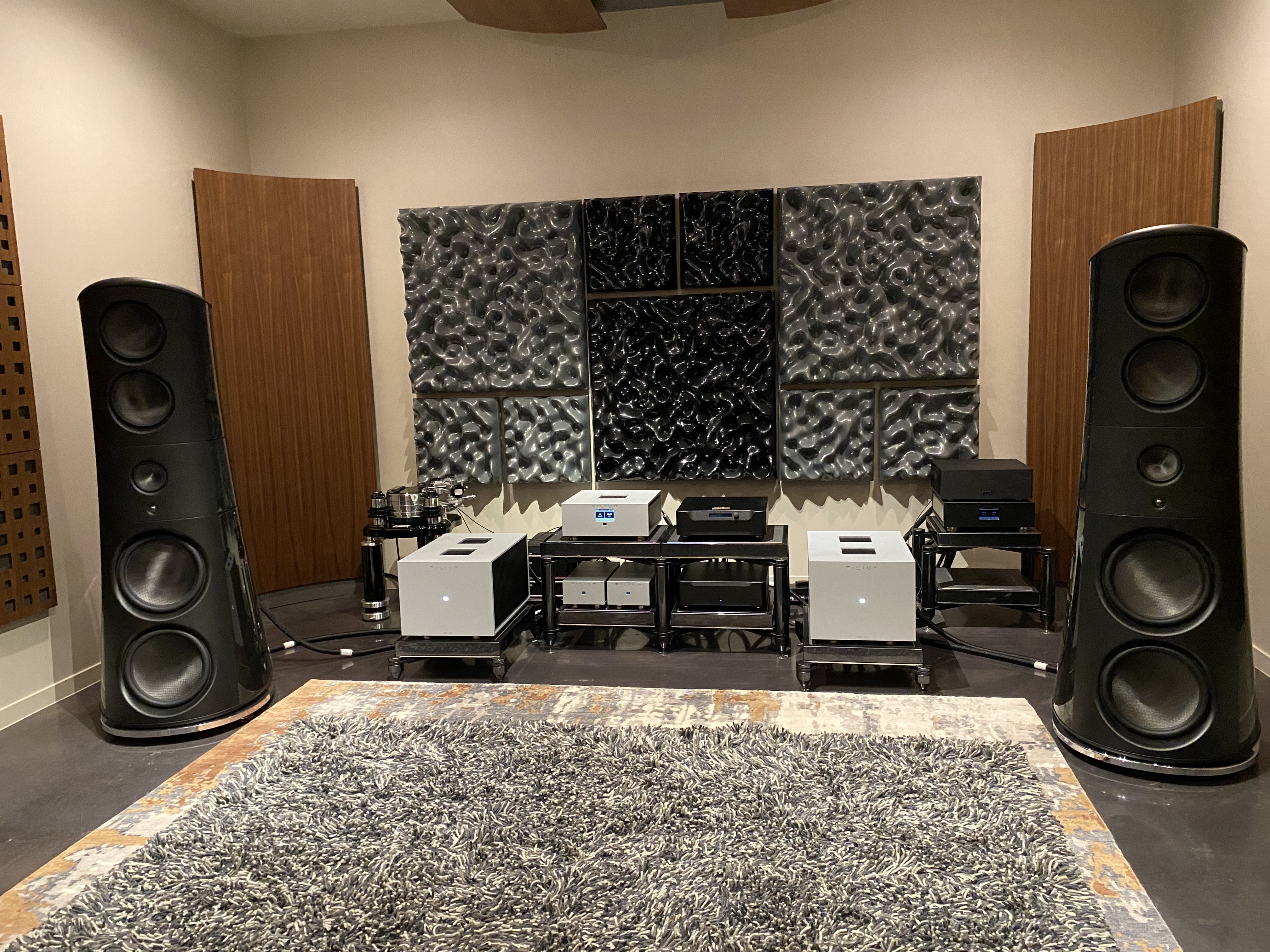
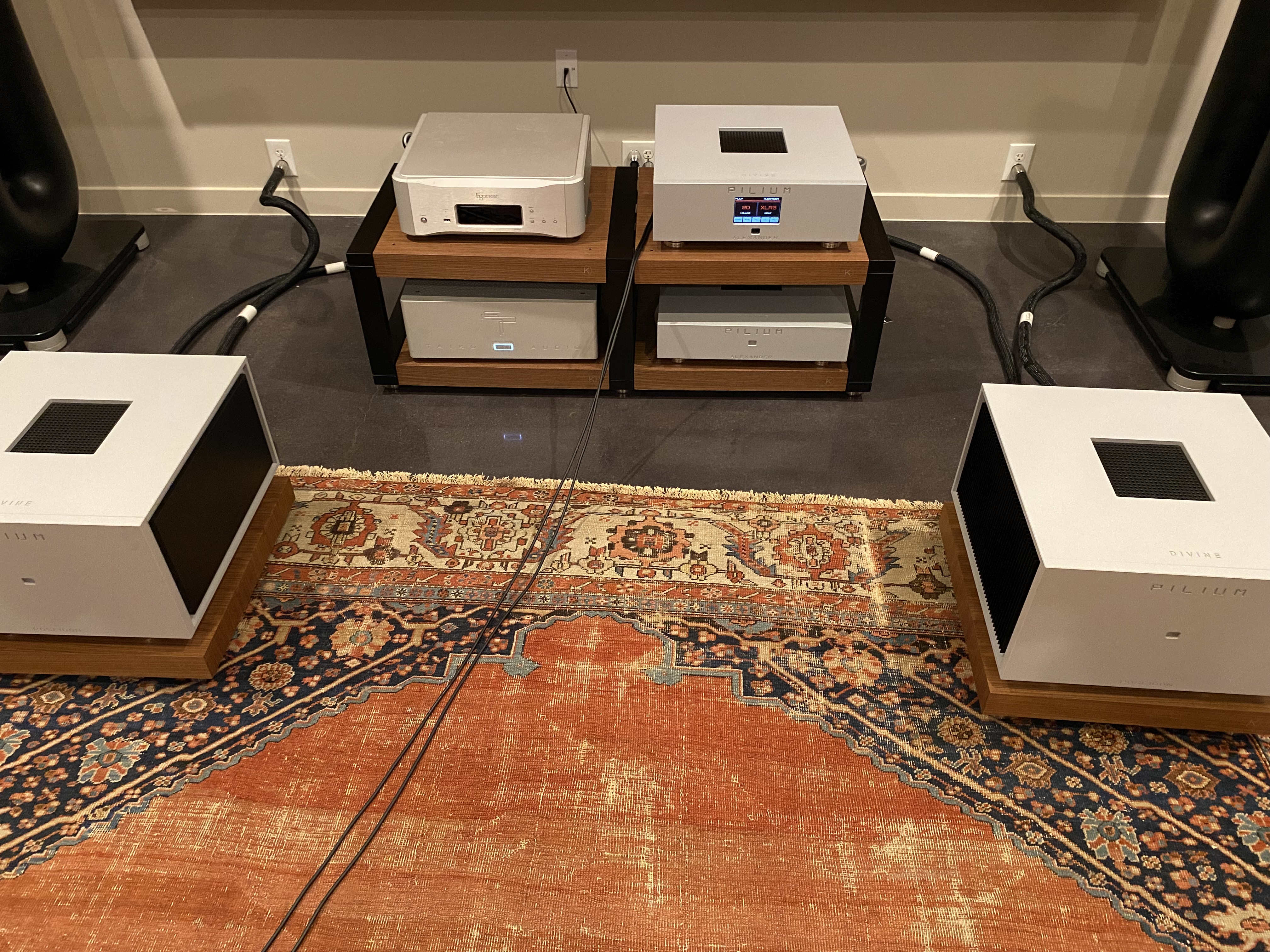
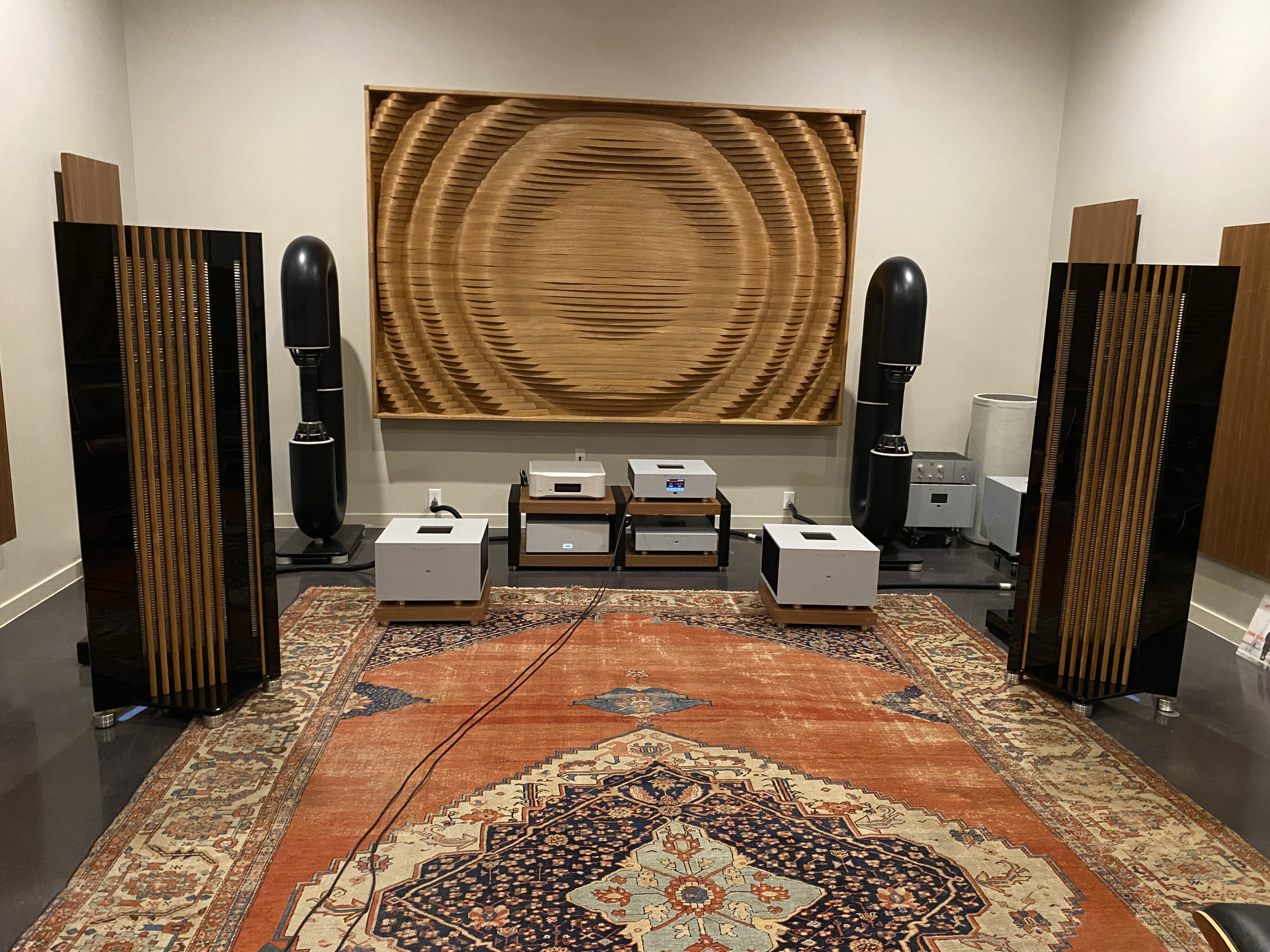
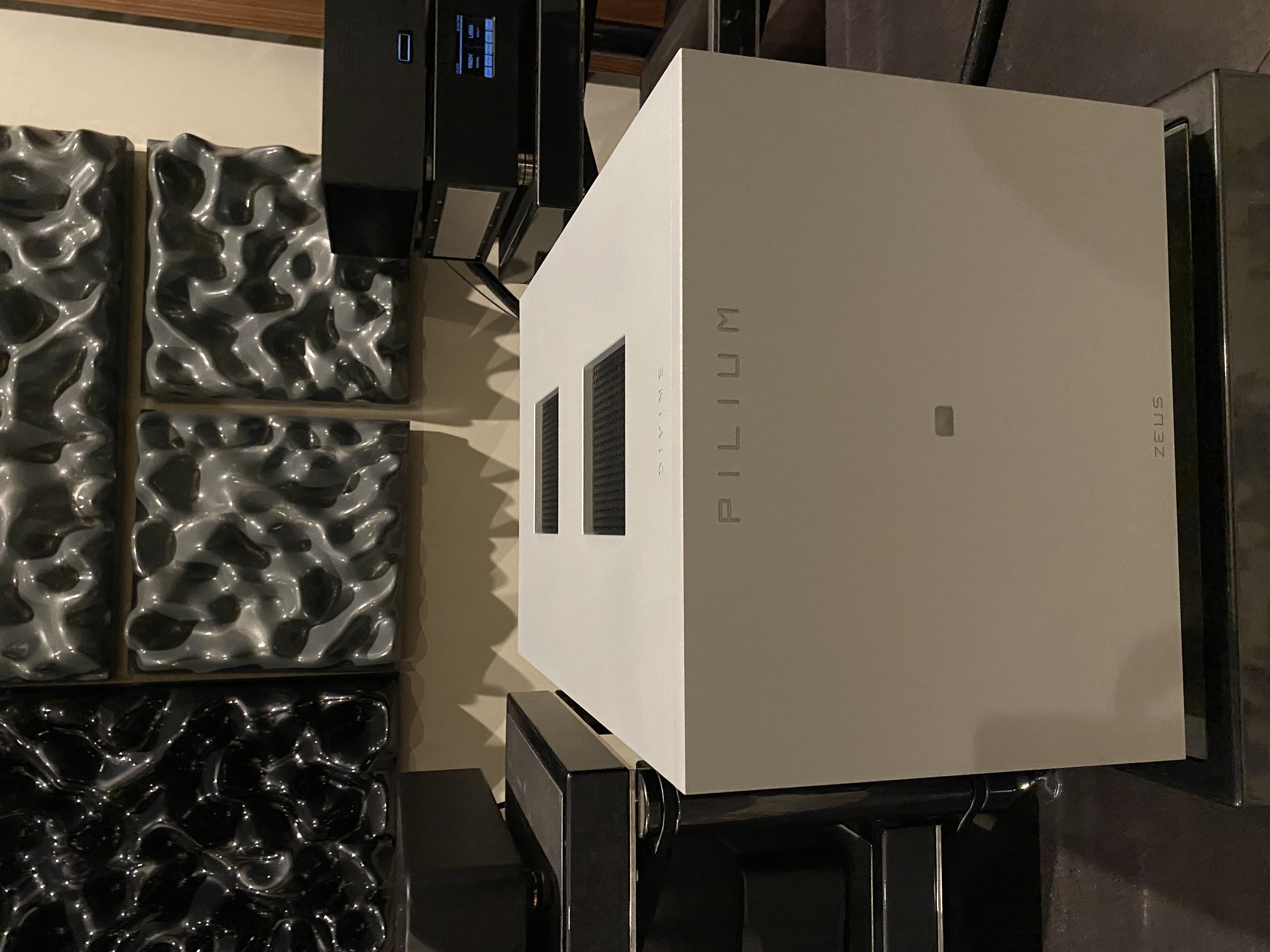
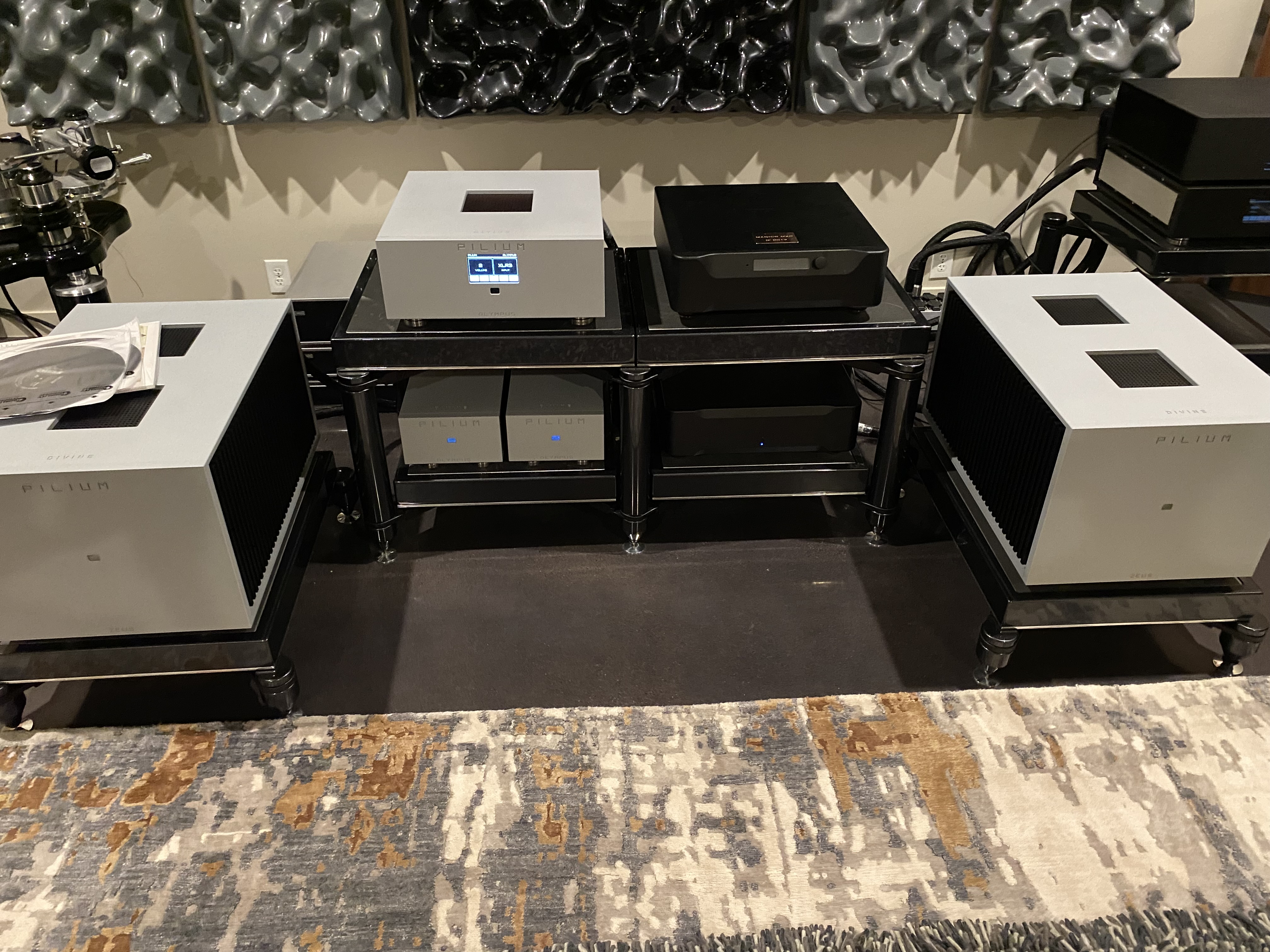
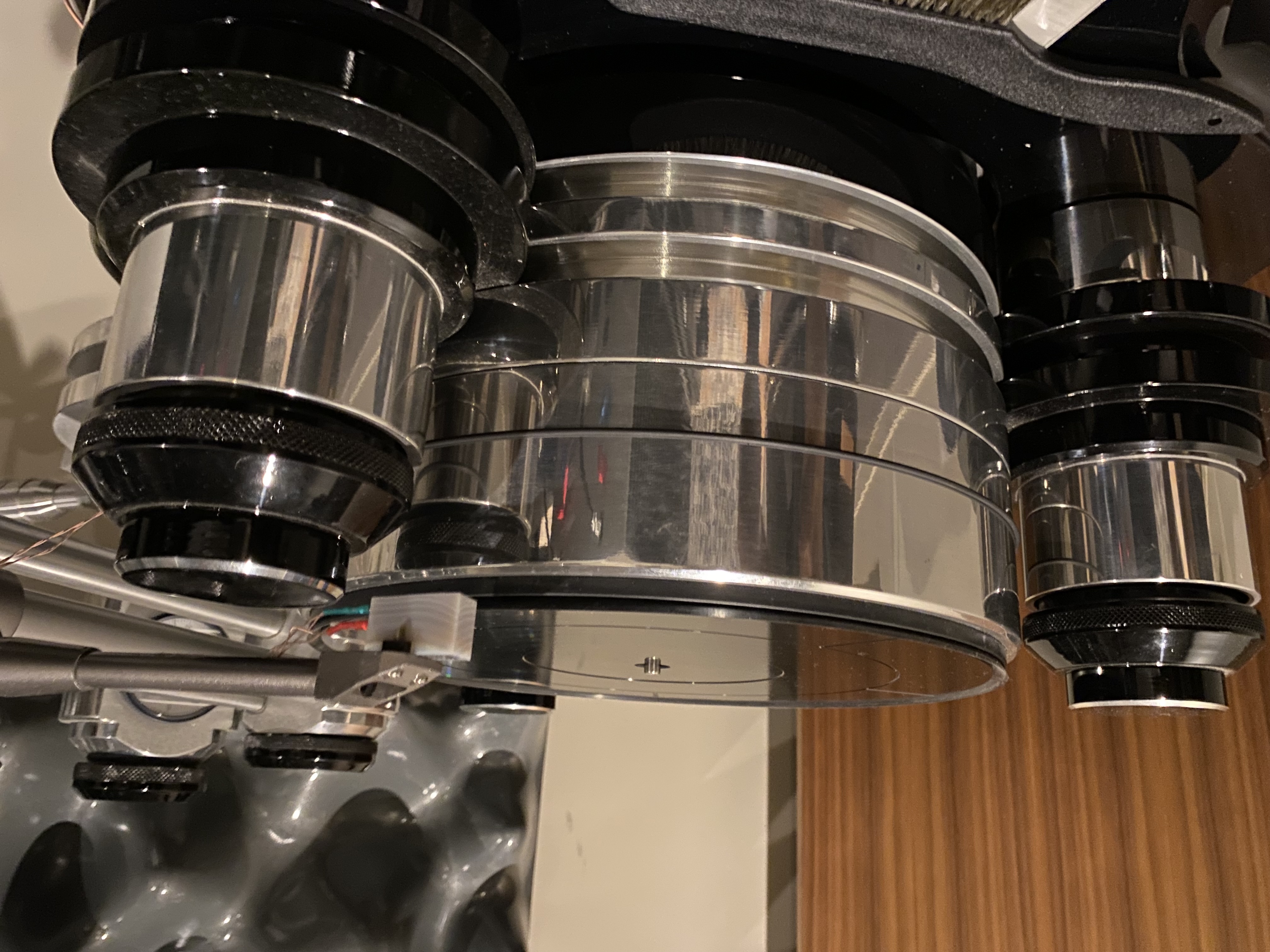
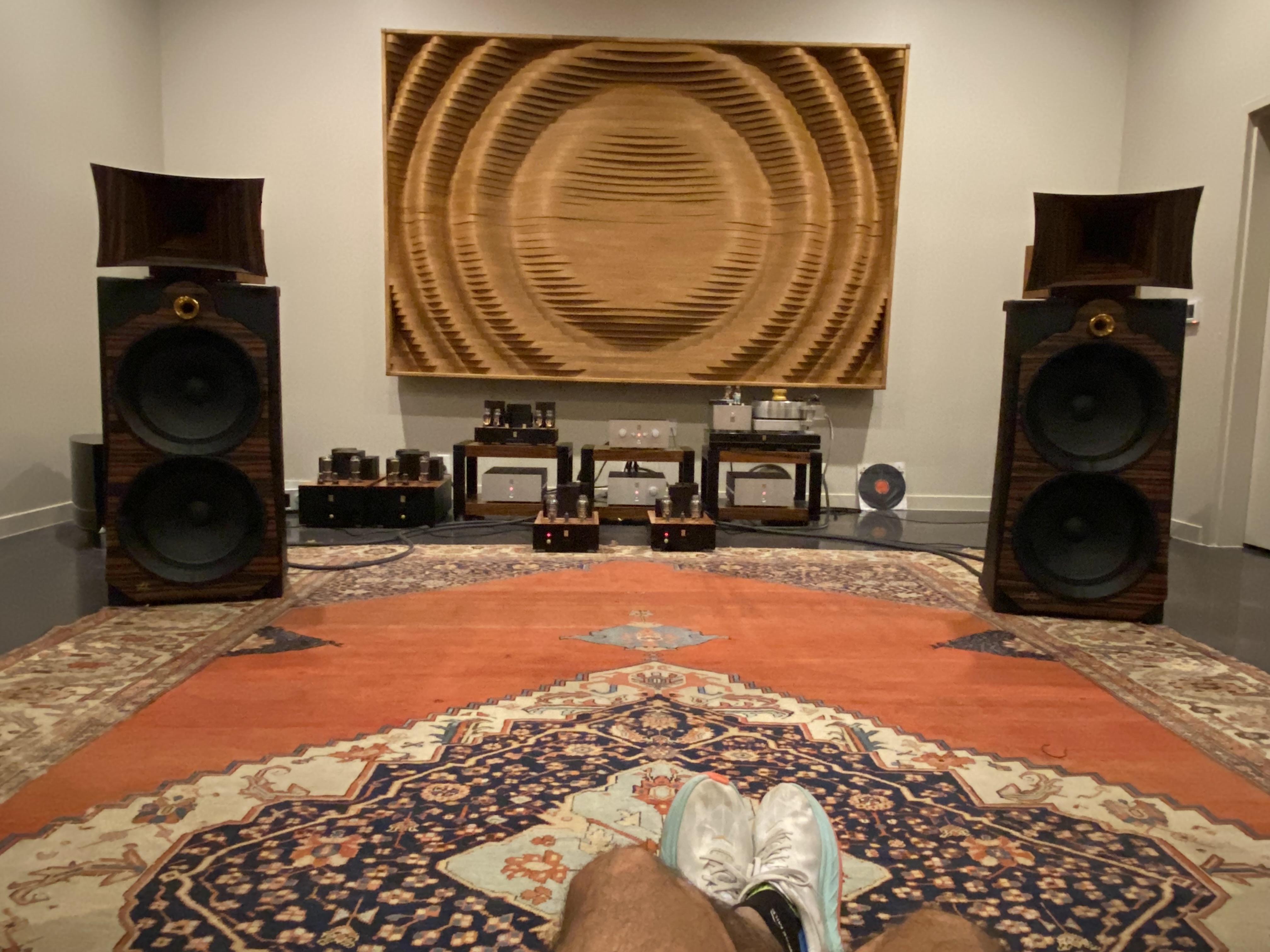
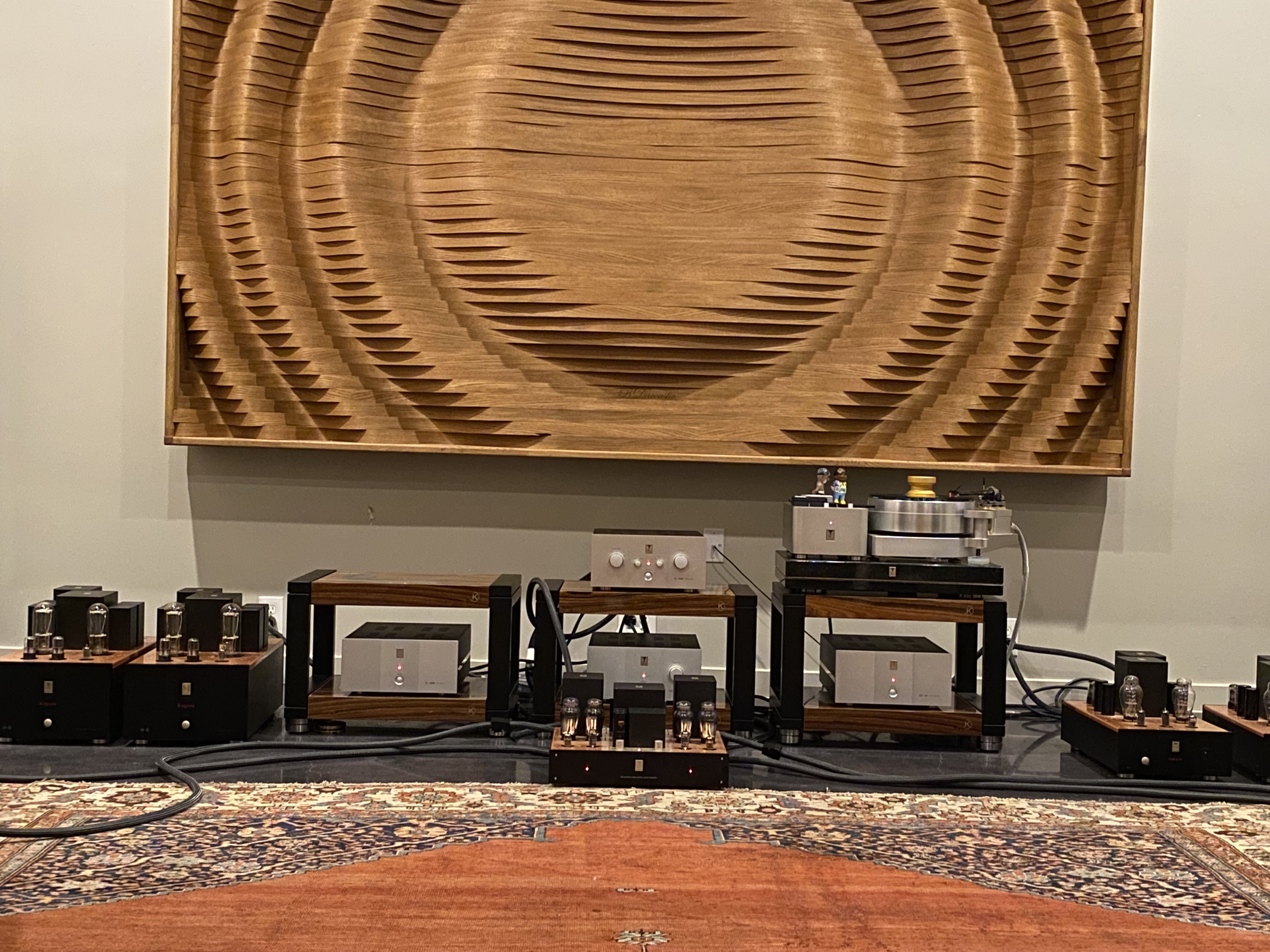
Be the first to comment on "Rhapsody Dallas – The Hamleys for Audiophiles"